Ever heard of a 1031 exchange? It might sound like a technical real estate term, but it’s actually a powerful strategy to grow your investments while deferring taxes when selling property. Whether you’re a seasoned investor or just dipping your toes into real estate, here’s a high-level breakdown of how it works—and why a Reverse 1031 Exchange might be worth considering too.
What Is a 1031 Exchange?
In simple terms, a 1031 exchange allows you to sell an investment property and defer capital gains taxes if you reinvest the profits into a “like-kind” property. The result? More money in your pocket to reinvest in your next real estate deal.
Perks of a 1031 Exchange:
- Tax Deferral: You get to defer paying capital gains taxes, giving you extra funds to reinvest in new properties.
- Portfolio Growth: Keep more of your profits, allowing you to expand into additional properties or different real estate sectors.
- Diversification: Want to swap a rental property for a commercial building? A 1031 exchange can make it happen.
Potential Downsides:
- Strict Timelines: You have 45 days to identify a new property and 180 days to close. Having a plan in place is key!
- Complex Rules: The new property must be of equal or greater value, and there’s IRS paperwork—but don’t worry, we can help with that.
- Transaction Costs: There are fees involved, but they’re often lower than people expect.
What’s a Reverse 1031 Exchange?
In a Reverse 1031 Exchange, you buy the new property first, then sell the original property within 180 days. This option is perfect if you spot a great deal but haven’t sold your current property yet.
Why Consider a Reverse 1031 Exchange?
- Less Pressure: You don’t need to rush to find a new property after selling.
- Stay Ahead of the Market: Lock in your next investment without the stress of selling your current property quickly.
The Catch:
- Financing Hurdles: Managing two properties at once can complicate financing, but I can guide you through the process.
- Higher Costs: Reverse exchanges are slightly more expensive since you’re temporarily managing two properties.
How the Process Works:
- Find a Qualified Intermediary (QI): You’ll need a third party to help you stay compliant with IRS rules—good news, we can connect you.
- Identify Your New Property: After selling your current property, you have 45 days to select up to three potential options for reinvestment.
- Close the Deal: You must close on the new property within 180 days of selling the original one.
- For Reverse 1031s: Buy the new property first, then sell the old one within 180 days.
Ready to Learn More?
1031 exchanges (and reverse 1031 exchanges) can be a smart way to grow your portfolio and maximize your investment returns. But, there are important rules and timelines to follow. If you’re curious whether a 1031 exchange could benefit you, reach out! I’d love to chat and help you figure out the best strategy for your investments.
#jameskingsellsnova #1031Exchange #RealEstateInvestment #TaxSavings #InvestmentStrategy #Reverse1031Exchange #GrowYourWealth #RealEstateTips #PortfolioGrowth #TaxDeferral


 Facebook
Facebook
 X
X
 Pinterest
Pinterest
 Copy Link
Copy Link


